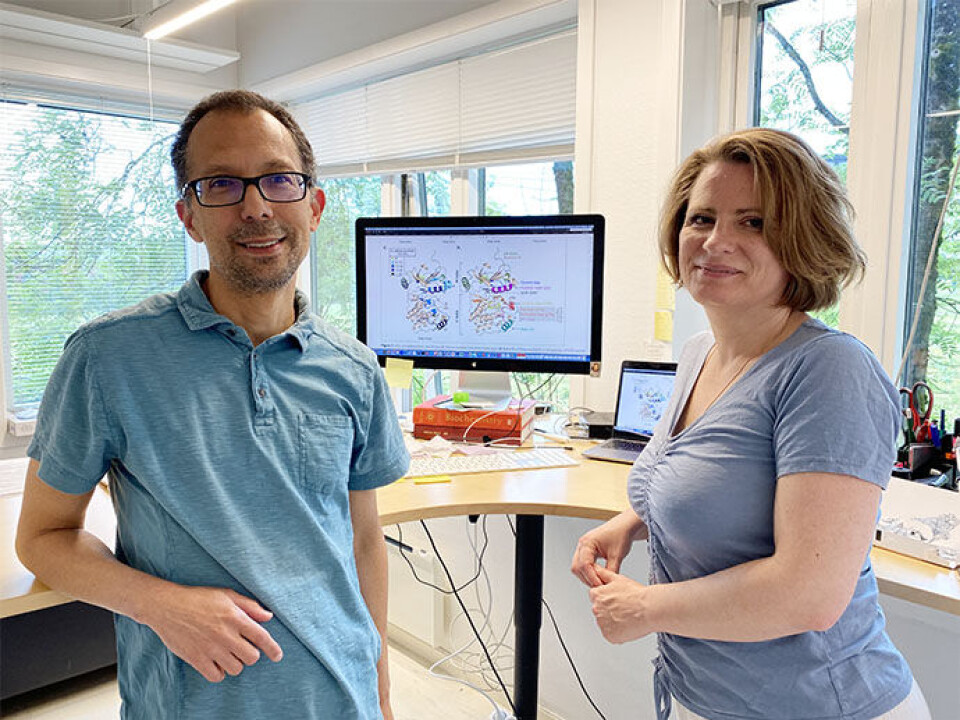THIS CONTENT IS BROUGHT TO YOU BY University of Oslo - read more

Cancer can be treated by blocking the conductor of cell division
New findings can lay the foundations for developing new cancer drugs.
Cell division is a fundamental process for all living things, where one cell divides into two cells. It allows for a human being to grow from a single fertilised egg cell, for wounds to heal, and for dead cells within your body to be replenished with new cells.
By the time you have read this sentence, millions of cells throughout your body have divided.
When a cell divides, it happens through a series of carefully controlled steps, and only when needed. Cancer, on the other hand, is characterised by cells having gained the ability to divide uncontrollably.
“We can say that cancer is a cell division disease. That’s why scientists are working to find new cancer treatments that disrupt the process of cell division, so that the cancer cells die instead of dividing,” Dario Segura-Peña says.

At the Centre for Molecular Medicine Norway (NCMM), Segura-Peña and colleagues in the Sekulic group have looked closer at an enzyme called Aurora B. It is particularly important for cell division. What they have discovered can lay the foundation for the development of new cancer treatments.
Aim to stop the conductor of cell division
Aurora B is an enzyme that acts as a conductor of cell division.
Aurora B is activated when the cell is going to divide and makes sure that the different steps are executed correctly and in the right order.
“If we disrupt the activity of Aurora B during cell division, the process will become so chaotic that the cell ends up dying instead of dividing. And that is exactly what we wish to happen to cancer cells,” Segura-Peña says.
In their study, the researchers show how the activity of Aurora B is turned on and off.
The goal is to use this knowledge as a basis for developing new drugs that kill cancer cells by preventing the activation of Aurora B during cell division.
A small modification with large effects
Therefore, the researchers looked at the on/off-switch of Aurora B and what happens to the protein structure of Aurora B when it is turned on.
The switch in Aurora B is a tiny molecular modification, called phosphorylation. This involves attaching a small phosphate molecule to the enzyme in order to turn it on.
It’s already known that phosphorylation of Aurora B causes a dramatic increase in its activity. But the changes that occur within Aurora B itself upon phosphorylation, was up until now not known.
“If we compare the sizes, then the attachment of a small phosphate molecule to Aurora B is like attaching a grain of sand to a tennis ball. We wondered how such a small modification could have such a strong effect on Aurora B activity during cell division,” Segura-Peña explains.
Zoomed in on the molecular level
To be able to see what happens to Aurora B when it is phosphorylated, the researchers zoomed in on the molecular level.
“Proteins are often depicted as static structures, but the reality is that within our cells they are far from static. They vibrate, almost breathe, and can change their structure to perform different tasks,” he says. “We have used a method, called HDX-MS, that allows us to see some of these movements in Aurora B, and how they change depending on whether it is turned on or off."
HDX-MS (hydrogen-deuterium exchange mass spectrometry) is a method that makes it possible to analyse the structure and dynamics of a protein.
With the help of HDX-MS and computer simulations, the researchers were able to see that the phosphorylation led to a change in the structure of Aurora B.
The protein structure went from being chaotic and inactive, to organised, well-structured, and synchronised in its motions.
Details can lay the foundations for developing drugs
And it is only when Aurora B is phosphorylated and organised that it can conduct the tasks that lead to cell division.
Knowing how an enzyme looks and functions helps to develop targeted drugs that specifically affect the active part of the enzyme.
Therefore, Segura-Peña hopes that their results bring us one step closer to being able to develop cancer treatments that block Aurora B activity and cell division.
“Our findings demonstrate the details around what happens on the structural level when Aurora B is activated. This gives us more avenues for developing new cancer therapies in the future,” he concludes.
Reference:
Segura-Peña et al. The structural basis of the multi-step allosteric activation of Aurora B kinase, eLife, 2023. DOI: 10.7554/eLife.85328

This article/press release is paid for and presented by the University of Oslo
This content is created by the University of Oslo's communication staff, who use this platform to communicate science and share results from research with the public. The University of Oslo is one of more than 80 owners of ScienceNorway.no. Read more here.
More content from the University of Oslo:
-
Putin’s dream of the perfect family
-
How international standards are transforming the world
-
A researcher has listened to 480 versions of Hitler's favourite music. This is what he found
-
Researcher: "AI weakens our judgement"
-
New, worrying trend among incels, according to researcher
-
Ship’s logs have shaped our understanding of the sea




































